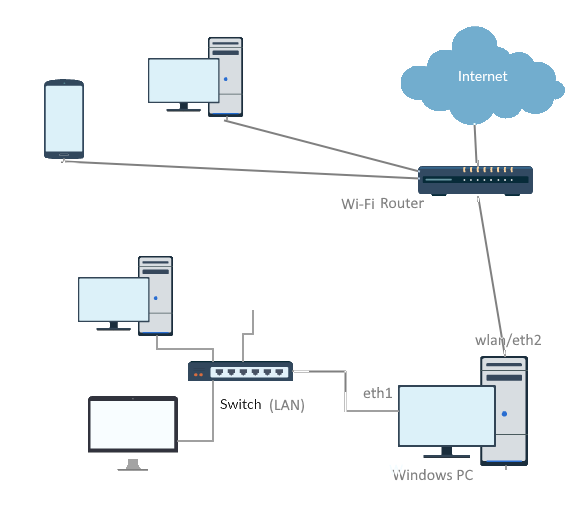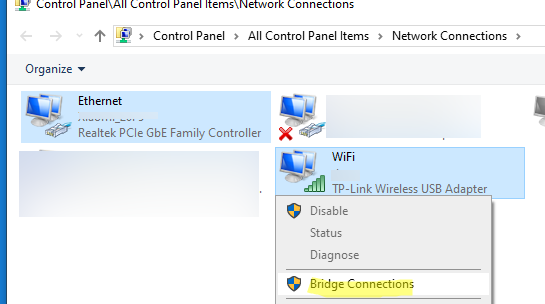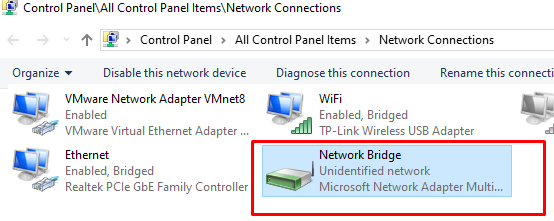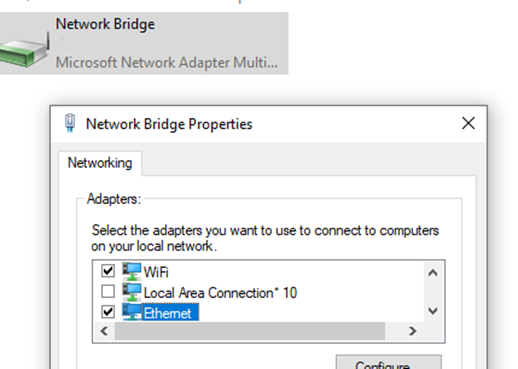В этой статье, мы рассмотрим, как настроить сетевой мост на компьютере под управлением Windows. Такой сетевой мост, работающий на канальном уровне модели OSI (L2), используется для прозрачного объединения двух и более сетей в одну общую сеть. Все версии Windows поддерживают объединение сетевых адаптеров в мост, никакое дополнительное ПО не потребуется.
В нашем примере у нас есть компьютер Windows с двумя сетевыми картами, подключенными в два разных сетевых сегмента. WLAN адаптер подключен к Wi-Fi сети (роутер с доступом в интернет), и Ethernet адаптер подключен к изолированной проводной локальной сети (LAN), построенной на коммутаторе. С помощью сетевого моста на Windows-компьютере вы прозрачно объединить две сети и все клиенты из изолированной сети (LAN) смогут получать доступ к ресурсам в основной сети и выходить в интернет через маршрутизатор.

Создать сетевой мост в Windows можно из стандартной панели управления сетевыми подключениями (
ncpa.cpl
). Выберите два (или) более сетевых адаптера, которые вы хотите объединить мост, и в меню выберите Bridge Connections.

Через некоторое время в списке сетевых адаптеров появится новый сетевой адаптер типа Microsoft Network Adapter Multiplexor Driver с именем Network Bridge.

При создании моста может появится ошибка:
An unexpected error occurred while configuring the Network Bridge.
В этом случае откройте свойства бриджа и отметьте сетевые адаптеры, которые должны объединяться вашим мостом.

После этого любые участвующих в мосте сетевых адаптеров, включая TCP/IP, станут недоступны для редактирования, а в описании адаптеров появится статус Bridged. Сетевой мост может включать в себя более двух сетевых адаптеров.
Теперь, если на роутере включен DHCP сервер, все клиенты в LAN получат IP адреса из внешней сети (на клиентских компьютерах должно быть включено автоматическое получение IP адресов от DHCP, либо IP адреса из одного сегмента нужно задать вручную). Таким образом вы прозрачно объедините две сети с помощью сетевого моста.
Если в сети отсутствует DHCP сервер, статические IP адреса для интерфейса bridge и на устройствах в объединенной сети можно назначить вручную.
Чтобы удалить сетевой мост, щелкните по немы и выберите Delete.
В старых версиях Windows сетевое подключение типа мост можно было только из графического интерфейса. При попытке выполнить команду
netsh bridge install
появлялась ошибка:
Not supported. Please go to the Network Connections folder to install.

В Windows 11 22H2 после установки кумулятивного обновления от 2023-09, можно создать сетевое подключение типа мост из командной строки с помощью утилиты netsh.
Выведите с помощью PowerShell имена сетевых интерфейсов в Windows:
Get-NetAdapter
Вывести доступные для добавления в мост сетевые адаптеры:
netsh bridge show adapter

Чтобы создать мост из двух интерфейсов, укажите из имена в следующей команде:
netsh bridge create Ethernet1 WiFi
После того как мост создан, получите его GUID:
netsh bridge list

Добавить или удалить сетевой адаптер в бридж:
netsh bridge add <Adapter_Name> to <bridge_guid>
netsh bridge remove <Adapter_Name> from <bridge_guid>
Удалить мост:
netsh bridge destroy <bridge_guid>
При объединении в мост Ethernet и Wi-Fi адаптеров, в Windows бридж работает некорректно, если одновременно оба устройства были отключены от сети, а потом подключены. В качестве обходного решения можно добавить в сетевой мост отдельное устройство, которое никогда не отключается. Проще всего это сделать, создав фиктивный Microsoft loopback adapter (в современных версиях Windows это устройство
Microsoft KM-TEST Loopback Adapter
). Можно создать адаптер из Device Manager или с помощью утилиты devcon:
./devcon.exe -r install $env:windir\Inf\Netloop.inf *MSLOOP
Для организации общего доступа к интернет-подключению в Windows можно использовать службу Internet Connection Sharing (ICS). В этом случае Windows компьютера будет выступать в качестве роутера (уровень L3/L4 OSI), а адреса клиентов буду скрываться за NAT. См. как создать точку доступа Wi-Fi и раздать интернет в Windows.
A network bridge in Windows 10 is a software or hardware component that connects two separate networks together, allowing devices from both networks to communicate with each other seamlessly. It acts as a mediator between different network segments, enabling devices on each network to share resources and access services.
Here are a few key points to consider when explaining what a network bridge is in Windows 10:
1. Purpose: The main purpose of a network bridge is to extend connectivity and facilitate communication between different networks, effectively creating a single unified network. It enables devices in one network segment to communicate with devices in another network segment as if they are part of the same network.
2. Functionality: In Windows 10, a network bridge combines multiple network interfaces or connections, such as Ethernet or Wi-Fi, into a single virtual network interface. This can be done through either software-based bridging or using a physical device such as a network switch.
3. Benefits: Network bridges offer several advantages, including eliminating the need for multiple IP subnets, simplifying network configuration, and enabling easier integration of different network protocols. It improves network performance by reducing broadcast traffic and increasing the overall bandwidth available to connected devices.
4. Setup: To create a network bridge in Windows 10, you need to access the «Network and Sharing Center» from the Control Panel. From there, you can select the network connections you want to bridge and create the bridge. It’s important to note that creating a bridge requires administrative privileges on the computer.
5. Considerations: When setting up a network bridge, it’s essential to ensure that the networks being bridged have compatible IP addressing schemes and network protocols. Additionally, bridging networks may require configuring appropriate firewall rules and security measures to maintain network integrity and protect against unauthorized access.
In conclusion, a network bridge in Windows 10 is a mechanism that connects multiple networks together, allowing devices from different segments to communicate seamlessly. It simplifies network configuration, enhances performance, and facilitates resource sharing between network segments.
Video Tutorial:What does network bridge do?
How do I use network bridge in Windows 10?
In Windows 10, you can use the network bridge feature to connect multiple networks together. Here’s a step-by-step guide on how to use network bridge:
Step 1: Open the Network Connections window by right-clicking on the Start button and selecting «Network Connections» from the context menu.
Step 2: In the Network Connections window, select the first network adapter or connection that you want to include in the bridge. Right-click on it and choose «Add to Bridge» or «Bridge Connections» from the options.
Step 3: Repeat the previous step for all the network adapters or connections that you want to include in the bridge.
Step 4: Once you have selected all the desired network adapters, right-click on one of them and choose «Bridge Connections» from the options. Windows will then create a network bridge and connect the selected networks together.
Step 5: Wait for Windows to create the bridge and establish the connections. This process may take a few moments.
Step 6: Once the bridge is created, you can access its properties by right-clicking on it and selecting «Properties» from the context menu. In the properties window, you can configure various settings such as IP addressing, protocols, and more.
Step 7: To remove the network bridge, simply right-click on it and choose «Delete» or «Remove from Bridge» from the options.
Using the network bridge feature in Windows 10 can be useful in scenarios where you need to combine multiple network connections, such as connecting your PC to both Wi-Fi and Ethernet networks simultaneously or sharing an internet connection between multiple devices. It allows for seamless communication between the connected networks, enabling data transfer and sharing resources across the bridge.
It’s worth noting that creating a network bridge requires administrative privileges, and it’s important to ensure compatibility and proper configuration of the networks and devices involved to avoid any potential conflicts or connectivity issues.
What is an example of a network bridge?
An example of a network bridge is a wired Ethernet bridge. A network bridge is a networking device that connects two separate networks and allows them to communicate with each other. It operates at the data link layer (Layer 2) of the OSI model and is typically used to extend a local area network (LAN) or connect LANs in separate physical locations.
Here’s a step-by-step explanation of how a wired Ethernet bridge works:
1. Identify the two networks you want to connect. These networks can be in different physical locations or segments, such as two separate buildings within a campus or two different floors in the same building.
2. Obtain a network bridge device, commonly known as a bridge or a bridge router. This device should have at least two Ethernet ports to connect the networks.
3. Connect one Ethernet port of the bridge device to the first network. This can be done by plugging an Ethernet cable from the bridge to a switch or a router on that network.
4. Connect the other Ethernet port of the bridge device to the second network in the same manner.
5. Configure the bridge device with appropriate settings. This may involve assigning IP addresses, subnet masks, and gateway information to the ports connected to each network.
6. Ensure that both networks have unique IP address ranges and don’t overlap. For example, if the first network uses the IP range 192.168.1.0/24, ensure that the second network uses a different range like 192.168.2.0/24.
7. Test the connectivity by connecting devices from each network to the bridge device. Verify that devices on one network can communicate with devices on the other network seamlessly.
By using a network bridge, you can effectively extend your LAN or connect separate LANs without the need for complex routing or additional equipment. This can be particularly useful in scenarios where running new network cabling is not feasible, but wired connectivity is required for reliable and high-speed network communication.
How do I remove a network bridge in Windows 10?
To remove a network bridge in Windows 10, follow these steps:
1. Open the Control Panel by searching for it in the Windows search bar.
2. In the Control Panel, click on «Network and Internet» or «Network and Sharing Center,» depending on your view settings.
3. Under the «Network and Sharing Center,» click on «Change adapter settings» located in the left sidebar.
4. You will see a list of network adapters. Look for the network bridge adapter. It is usually named «Network Bridge» or «Bridge Connections.«
5. Right-click on the network bridge adapter and select «Delete» or «Remove.» You may be prompted to provide administrator permissions.
6. Confirm the deletion of the network bridge when prompted.
By following these steps, you should be able to remove a network bridge in Windows 10 effectively.
What is the difference between network bridge and router?
Network Bridge and Router serve different purposes in a network environment. Here are the key differences between the two:
1. Function: A network bridge operates at Layer 2 of the OSI model and connects two separate networks, allowing them to communicate as one. It simply extends the network by forwarding data between two physical or virtual network segments without modification. On the other hand, a router operates at Layer 3 and connects different networks (LANs, WANs, or the Internet) by choosing the best path for data packets to reach their destination.
2. Addressing: A bridge works with MAC addresses, which are unique identifiers assigned to network interfaces, to forward traffic between connected networks. It doesn’t modify the source or destination addresses of the data packets. In contrast, a router uses IP addresses to direct traffic. It examines the IP header of a packet and determines the optimal path to forward the packet based on the destination IP address.
3. Decision Making: Bridges make forwarding decisions based on the destination MAC address present in the frame’s header. They maintain a MAC address table to keep track of which devices are connected to each network segment. Routers, on the other hand, utilize routing tables, which store information about networks and their associated IP addresses, to make intelligent decisions regarding the path of data packets.
4. Network Segmentation: Bridges are commonly used to segment large networks into smaller parts to improve performance and security, such as dividing a LAN into multiple smaller LANs. Routers, on the other hand, connect different networks and enable communication between them.
5. Broadcast Domain: Bridges extend the broadcast domain, meaning that broadcasts sent on one side of the bridge will be received by devices on the other side. Routers, however, do not propagate broadcast messages. They use techniques like network address translation (NAT) to allow multiple devices on a network to share a single public IP address.
6. Network Layer Functions: Routers provide additional functionalities at the network layer, such as network address translation (NAT), port forwarding, firewall capabilities, and traffic shaping. These features give routers more control over network traffic and enhance network security.
In summary, network bridges primarily extend networks and connect two separate networks as one, while routers connect different networks and make intelligent decisions about routing data packets between them. Routers offer more advanced functionalities at the network layer and are commonly used for connecting networks and providing access to the Internet.
As a tech blogger, I can provide a professional perspective on the safety of bridge networks.
1. Definition of bridge networks: A bridge network is a type of network that connects two separate networks together, allowing them to communicate with each other. It operates at the data link layer (Layer 2) of the OSI model.
2. Isolation and security: One of the main advantages of bridge networks is the isolation they provide. By connecting different networks, bridge networks can separate traffic and increase security by limiting access between networks. This isolation can help prevent unauthorized access and reduce the risk of potential security breaches.
3. Enhanced security protocols: Bridge networks generally support various security protocols, such as MAC filtering, VLAN tagging, and port security features. These protocols add an extra layer of security by controlling access to the network, ensuring that only authorized devices or users can connect.
4. Monitoring and management tools: Bridge networks often come with monitoring and management tools that allow network administrators to track and analyze network traffic. These tools can help detect and respond to any unusual or suspicious activities, further enhancing network security.
5. Vulnerabilities and considerations: While bridge networks offer increased security, it’s important to note that no network is entirely immune to vulnerabilities. It’s crucial to regularly update and patch network devices, maintain strong authentication methods, and conduct security audits to identify and address any potential weaknesses.
6. Network architecture and design: The overall security of bridge networks also depends on how they are architected and designed. Implementing best practices, such as segmenting the network into smaller subnets, using firewalls, and employing secure configurations, can further enhance the safety of bridge networks.
In conclusion, bridge networks can be considered safe when implemented correctly and coupled with appropriate security measures. However, it’s important to continually monitor, update, and maintain the network’s security to mitigate potential risks.
What does bridging Wi-Fi and Ethernet do?
Bridging Wi-Fi and Ethernet allows you to connect devices on Wi-Fi and Ethernet networks together, creating a unified network. This can be useful in several scenarios:
1. Expanding Wi-Fi coverage: If you have a Wi-Fi router in one part of your home or office and want to extend the network’s coverage to another area, you can use a bridge to connect an additional Wi-Fi access point via Ethernet. This setup enables a seamless Wi-Fi experience throughout the entire space.
2. Connecting wired devices to a wireless network: A bridge allows you to connect devices that only have Ethernet connectivity to a Wi-Fi network. This is especially useful for devices such as gaming consoles, smart TVs, or network-enabled printers that lack built-in Wi-Fi capabilities. By connecting them to a bridge, you can access the wireless network without needing to run Ethernet cables to each device.
3. Enhanced network performance: In certain situations, bridging Wi-Fi and Ethernet can improve network performance. For example, if you have multiple Wi-Fi access points in a large home or office, connecting them via Ethernet can help create a more reliable and robust network, reducing interference and ensuring faster connectivity.
Here’s a step-by-step guide to bridging Wi-Fi and Ethernet:
1. Connect your Wi-Fi router to your modem or internet source and ensure it is functioning correctly.
2. Choose a suitable Wi-Fi access point or Wi-Fi bridge device that supports Ethernet connectivity.
3. Connect the Ethernet cable from the Wi-Fi bridge device to an available Ethernet port on your router.
4. Follow the manufacturer’s instructions to configure the Wi-Fi bridge device. This generally involves connecting to the device’s management interface via a web browser.
5. Set up the bridge device to connect to your existing Wi-Fi network. Provide the necessary credentials such as the network name (SSID) and password.
6. Once configured, the Wi-Fi bridge device will connect to your Wi-Fi network and establish a bridge between the Wi-Fi and Ethernet networks.
7. Connect devices that need Ethernet connectivity to the Ethernet ports on the bridge device. These devices will now be able to access the Wi-Fi network as if they were directly connected.
Remember to configure and secure your Wi-Fi network appropriately to ensure a safe and reliable connection for all your connected devices.
A network bridge connects two separate computer networks, allowing them to communicate with each other and expand the overall network reach. They’re commonly used to connect LANs, but WiFi networks, and WiFi and LAN networks can also be bridged together. Two bridged networks can communicate with each other, and they act as one however, you cannot bridge two networks together and expect to combine their speed. For example, if you combine a 20Mbps connection with another 20Mbps connection, you will not get 40Mbps download speed.
A network bridge works on the second layer of the OSI model where data transfer occurs between adjoining nodes. These can be nodes on a WAN or LAN. This layer has two layers under it, one of which is the Media Access Control Layer aka the MAC layer.
Bridge vs Repeater
A bridge might seem similar if not the same as a repeater however, there’s a difference. A repeater is like a signal amplifier; it listens for incoming signal, boosts it, and sends it down the line to be heard.
A bridge on the other hand listens to the incoming signal, understands where it comes from and where it needs to go, and only directs it accordingly.
A bridge is essentially smarter than a Repeater. A repeater is passing on a signal without regard to where it needs to be sent or where it’s coming from while the bridge will make sure the signal only goes where it needs to. It’s ideal for networks that are segregated because it can divide large networks into smaller networks.
Physical vs Virtual Bridge
A bridge is often created using a physical device. The device can be somewhat cheap but good ones are usually more expensive. If you’re looking to bridge a LAN, you might want to go for a physical device. If your needs for bridging networks is small-scale and you have a Windows or Mac machine with a network card that supports it, you can create a virtual bridge between a LAN and WiFi network.
Virtual Network Bridge
You can create a virtual network bridge on Windows 10 and on macOS. You will need admin rights to create a network bridge.
Windows 10
On Windows 10, open File Explorer and paste the following in the location bar.
Control Panel\Network and Internet\Network Connections
Make sure you’re connected to both the networks you want to bridge. Select both networks, and right-click any one of them. Select the ‘Bridge’ option from the context menu. Wait a few seconds for the bridged network to be created.
You can disable a bridged network, or you can remove networks from a bridge. Right-click the bridged network and select Disable or right-click one of the networks in the bridged network, and select Remove from bridge option.
You will have to remove both networks individually and you should wait for one network to be removed before you remove the next one or you might run into a BSOD.
macOS
On macOS, open System Preferences, and select the Network preference. Click the cog wheel button at the bottom of the left column and select ‘Manage Virtual Interfaces…’.
In the pop-up window, click the plus button and select ‘New Bridge’ from the menu. Select the networks you want to include in the bridge, and you’re good to go.

Fatima Wahab
Fatima has been writing for AddictiveTips for six years. She began as a junior writer and has been working as the Editor in Chief since 2014.
Fatima gets an adrenaline rush from figuring out how technology works, and how to manipulate it. A well-designed app, something that solves a common everyday problem and looks
Если просто собрать компьютер с двумя сетевыми картами и подключить его к двум разным сетям, то этот компьютер будет видеть все удаленные системы, а все члены сетей увидят в сетевом окружение роутер, но не более того. Чтобы компьютеры разных сегментов видели друг друга, необходимо создать сетевой мост.
Создание сетевого моста поддерживают Windows NT/2000/2003/XP
Для этого зайдите: «Пуск»>»Настройка»>»Панель Управления»>»Сетевые подключения»
Выделите сетевые подключения, которые нужно скоммутировать, и кликните на них правой кнопкой мыши, выбрав в контекстном меню «Подключение типа мост».
Появится новое соединение «Сетевой мост».
Сетевой мост не будет работать, если хотя бы у одного из соединений, входящих в него, будет включена служба «Автоматического назначения IP-адресов». По возможности лучше, чтобы IP адреса разных сегментов сети не пересекались. Мост может быть только один, но при этом он может включать в себянеограниченное количество сетевых интерфейсов. До тех пор, пока существует сетевой мост, изменение каких либо параметров сети невозможно, если это по каким либо причинам требуется, сетевой мост нужно удалить, внести исправления, а затем вновь его создать.
Сетевой мост используется для дешевого и легкого подключения сегментов ЛВС. Сегмент локальной сети — это часть сетевого носителя, связывающая между собой группу компьютеров. Чаще всего сеть состоит из нескольких сегментов ЛВС. До появления операционных систем Windows XP;, Windows Server 2003, Standard Edition и Windows Server 2003, Enterprise Edition для создания сети, содержащей несколько сегментов ЛВС, использовалось два способа: IP-маршрутизация и мостовое оборудование. Для IP-маршрутизации необхода покупка аппаратных маршрутизаторов или настройка компьютеров и назначение IP-адресов для каждого компьютера на каждом сегменте сети, а также настройка каждого сегмента сети как отдельной подсети. Мостовое оборудование не требует такой сложной настройки, но в этом случае понадобится дополнительное оборудование для мостов. При использовании различных типов сетевых носителей необходимо будет создать отдельную подсеть для каждого типа носителя.
Различия между коммутаторами и мостами
В общем случае коммутатор (свитч) и мост аналогичны по функциональности; разница заключается во внутреннем устройстве: мосты обрабатывают трафик, используя центральный процессор, коммутатор же использует коммутационную матрицу (аппаратную схему для коммутации пакетов). В настоящее время мосты практически не используются (так как для работы требуют производительный процессор), за исключением ситуаций, когда связываются сегменты сети с разной организацией первого уровня, например, между xDSL соединениями, оптикой, Ethernet’ом.
